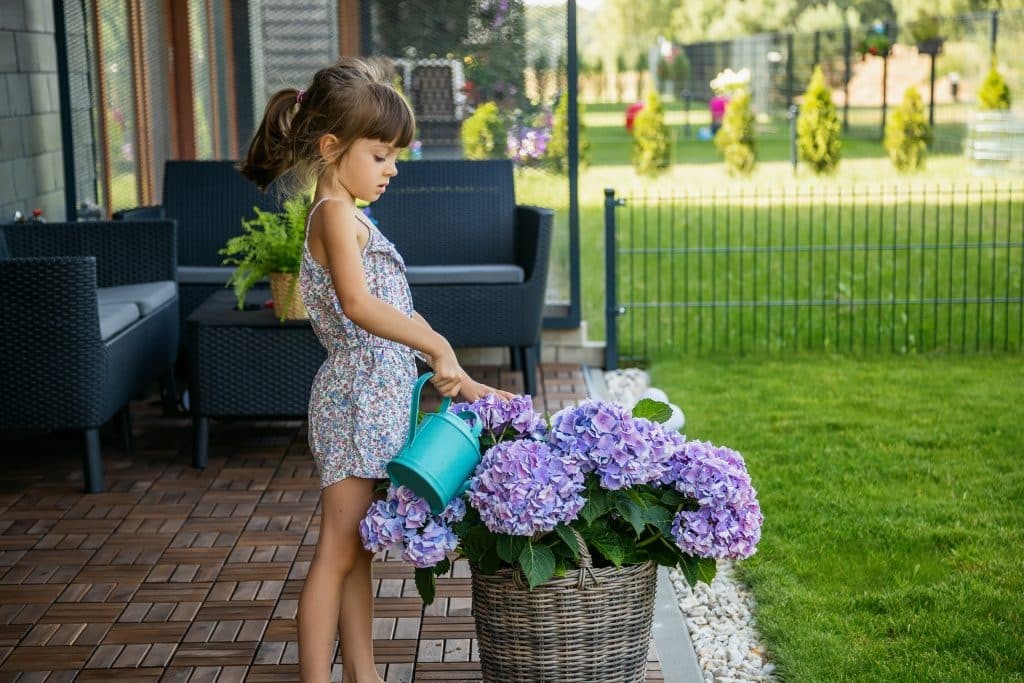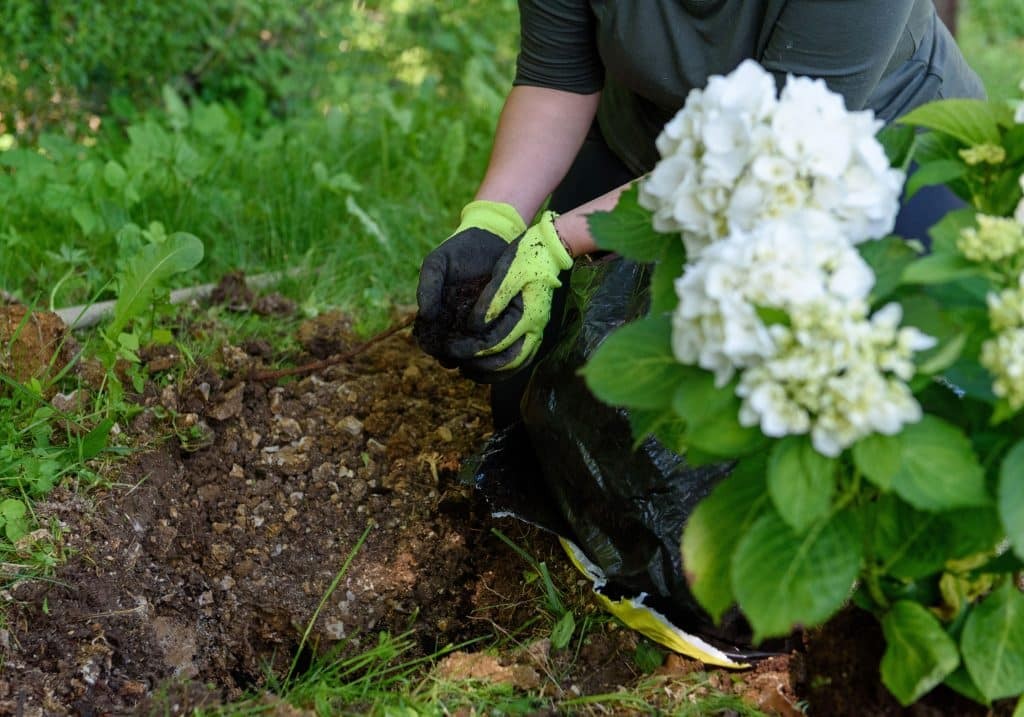Hydrangeas, renowned for their stunning blooms, can sometimes display a disheartening sight: wilting. Understanding the underlying reasons is crucial for restoring their vitality. Are your hydrangeas drooping despite your best efforts? This comprehensive guide, brought to you by WHY.EDU.VN, delves into the common causes of hydrangea wilt and provides practical solutions to revive your beloved plants. Learn about hydration issues, light imbalances, and soil problems that can lead to wilting, and discover how to implement effective care strategies. Let’s explore hydration management, light requirements, and soil enhancement.
1. Understanding the Primary Causes of Hydrangea Wilting
Several factors can contribute to wilting hydrangeas. Identifying the root cause is the first step towards effective treatment.
-
1.1 Insufficient Watering: The Hydration Foundation
Hydrangeas, aptly named from the Greek “hydros” meaning water, are thirsty plants. Insufficient watering is a prime culprit behind wilting, even without extreme heat or drought. Their fibrous roots need consistent moisture to maintain turgidity, the internal pressure that keeps leaves and stems firm. When water is scarce, the plant loses this pressure, resulting in drooping leaves and stems unable to support the heavy blooms. This is especially prevalent during hot weather or in well-draining soils that don’t retain moisture.
-
1.2 Overwatering: A Delicate Balance
While hydrangeas love water, too much can be detrimental. Overwatering can lead to root rot, hindering the plant’s ability to absorb water and nutrients. Soggy soil suffocates the roots, preventing them from functioning properly. Symptoms of overwatering include yellowing leaves, a musty smell, and a general decline in the plant’s health. Proper drainage is essential to prevent this issue.
-
1.3 Heat Stress: Battling the Elements
Hydrangeas are susceptible to heat stress, particularly during scorching summer days. Excessive heat causes the plant to lose water faster than it can absorb it, leading to dehydration and wilting. Prolonged exposure to direct sunlight, especially in the afternoon, can exacerbate this problem. Protecting your hydrangeas from intense heat is crucial for their well-being.
-
1.4 Sunlight Imbalance: Finding the Sweet Spot
Hydrangeas need sunlight, but the amount varies depending on the variety and climate. Too much direct sunlight can scorch the leaves and cause wilting, while too little sunlight can weaken the plant and reduce blooming. Finding the right balance is key. Morning sun and afternoon shade are often ideal, providing sufficient light without overheating the plant.
-
1.5 Soil Issues: The Root of the Problem
The soil plays a vital role in hydrangea health. Poor soil quality, inadequate drainage, or nutrient deficiencies can all contribute to wilting. Compacted soil restricts root growth and water absorption, while sandy soil drains too quickly. A soil test can reveal nutrient imbalances, such as excess nitrogen or a lack of essential minerals, which can negatively impact the plant’s health.
2. Diagnosing the Cause: Identifying the Culprit
Before taking action, carefully assess your hydrangea and its environment to pinpoint the cause of wilting.
- 2.1 Evaluate Watering Practices:
- How often do you water?
- How much water do you provide each time?
- Is the soil consistently moist or dry to the touch?
- Does water drain well from the pot or garden bed?
- 2.2 Assess Sunlight Exposure:
- How many hours of direct sunlight does the plant receive each day?
- Is the sunlight more intense in the morning or afternoon?
- Are the leaves showing signs of sunburn, such as brown spots or bleached areas?
- 2.3 Inspect the Soil:
- Is the soil compacted or loose and well-draining?
- Does the soil retain moisture well, or does it dry out quickly?
- Has the soil been recently fertilized?
- Consider performing a soil test to determine pH and nutrient levels.
- 2.4 Examine the Plant:
- Are the leaves uniformly wilted, or are certain sections more affected?
- Are the leaves yellowing, browning, or showing other signs of discoloration?
- Are there any signs of pests or diseases, such as spots, holes, or webbing?
- Are the stems brittle or flexible?
- 2.5 Consider Recent Changes:
- Have there been any recent changes in the weather, such as a sudden heat wave or drought?
- Have you recently transplanted or pruned the hydrangea?
- Have you applied any new fertilizers or pesticides?
3. Implementing Solutions: Reviving Your Hydrangeas
Once you’ve identified the cause of wilting, take appropriate action to address the problem and restore your hydrangea’s health.
-
3.1 Adjust Watering Practices:
- If underwatering is the issue: Water deeply and regularly, ensuring the soil is consistently moist but not soggy. Use a soaker hose or drip irrigation to deliver water directly to the roots. Mulch around the base of the plant to help retain moisture.
- If overwatering is the issue: Allow the soil to dry out completely between waterings. Improve drainage by amending the soil with organic matter or transplanting the hydrangea to a better-draining location. Ensure the pot has drainage holes.
-
3.2 Optimize Sunlight Exposure:
- If the plant is getting too much sun: Provide shade during the hottest part of the day, especially in the afternoon. Use shade cloth, plant the hydrangea near a taller tree or shrub, or move it to a more shaded location.
- If the plant is not getting enough sun: Transplant the hydrangea to a sunnier location or prune nearby trees or shrubs to allow more sunlight to reach the plant.
-
3.3 Improve Soil Conditions:
- Amend the soil: Add organic matter, such as compost, peat moss, or well-rotted manure, to improve soil drainage, water retention, and nutrient content.
- Adjust soil pH: Hydrangeas prefer slightly acidic soil (pH 6.0-6.5). Use soil amendments, such as sulfur or aluminum sulfate, to lower the pH if necessary.
- Fertilize properly: Use a balanced fertilizer specifically formulated for hydrangeas. Avoid over-fertilizing, which can lead to weak growth and other problems. Conduct a soil test to determine nutrient deficiencies and fertilize accordingly.
-
3.4 Address Pests and Diseases:
Regularly inspect your hydrangeas for signs of pests or diseases. Treat any infestations or infections promptly with appropriate insecticides or fungicides. Ensure good air circulation around the plant to prevent fungal diseases.
-
3.5 Prune Appropriately:
Prune dead, damaged, or diseased branches to improve air circulation and encourage new growth. Different hydrangea varieties require different pruning techniques, so research the specific needs of your plant.
-
3.6 Provide Support:
If the stems are weak and unable to support the flower heads, provide support with stakes or cages. This is especially important for hydrangeas with large, heavy blooms.
4. Prevention is Key: Maintaining Healthy Hydrangeas
Preventing wilting is always better than trying to revive a stressed plant. By following these tips, you can keep your hydrangeas healthy and vibrant:
- 4.1 Choose the Right Location: Select a location that provides the appropriate amount of sunlight and shade for your specific hydrangea variety.
- 4.2 Prepare the Soil: Amend the soil with organic matter before planting to improve drainage, water retention, and nutrient content.
- 4.3 Water Deeply and Regularly: Water deeply and regularly, especially during hot, dry weather.
- 4.4 Mulch Around the Base: Apply a layer of mulch around the base of the plant to conserve moisture, regulate soil temperature, and suppress weeds.
- 4.5 Fertilize Sparingly: Use a balanced fertilizer specifically formulated for hydrangeas, and avoid over-fertilizing.
- 4.6 Monitor for Pests and Diseases: Regularly inspect your hydrangeas for signs of pests or diseases, and treat any problems promptly.
- 4.7 Prune Appropriately: Prune your hydrangeas at the right time of year, according to the specific needs of your variety.
- 4.8 Protect from Extreme Weather: Provide shade during heat waves and protect from frost or heavy snow.
5. Specific Hydrangea Varieties and Their Needs
Understanding the specific needs of your hydrangea variety is crucial for proper care. Here’s a brief overview of some popular types:
| Variety | Sunlight | Watering | Pruning | Soil pH |
|---|---|---|---|---|
| Bigleaf (Hydrangea macrophylla) | Morning sun, afternoon shade | Regular, deep watering | Prune after flowering (for repeat bloomers) or in late winter (for others) | Acidic to neutral |
| Panicle (Hydrangea paniculata) | Full sun to partial shade | Regular watering | Prune in late winter or early spring | Adaptable |
| Smooth (Hydrangea arborescens) | Partial shade | Regular watering | Prune in late winter or early spring | Adaptable |
| Oakleaf (Hydrangea quercifolia) | Morning sun, afternoon shade | Regular watering | Prune after flowering | Acidic |


6. Advanced Techniques for Hydrangea Care
For experienced gardeners, consider these advanced techniques to optimize hydrangea health:
- 6.1 Soil Testing and Amendments: Conduct regular soil tests to monitor pH and nutrient levels. Amend the soil as needed with specific nutrients or soil amendments to address any imbalances.
- 6.2 Water Quality Management: Use rainwater or filtered water to avoid tap water containing chlorine or other chemicals that can harm hydrangeas.
- 6.3 Companion Planting: Plant companion plants, such as marigolds or lavender, to deter pests and attract beneficial insects.
- 6.4 Propagation: Propagate new hydrangeas from cuttings to expand your collection or share with friends.
- 6.5 Winter Protection: Provide winter protection, such as wrapping the plant in burlap or mulching heavily around the base, to protect against cold damage.
- 6.6 Vertical Gardening: Utilize vertical gardening techniques to create visually appealing hydrangea displays in limited spaces.
7. The Role of Technology in Hydrangea Care
Modern technology can assist in maintaining optimal hydrangea health:
- 7.1 Smart Irrigation Systems: Utilize smart irrigation systems that automatically adjust watering based on weather conditions and soil moisture levels.
- 7.2 Soil Moisture Sensors: Employ soil moisture sensors to monitor soil moisture levels and ensure adequate hydration.
- 7.3 Weather Monitoring Apps: Use weather monitoring apps to anticipate extreme weather events and take proactive measures to protect your hydrangeas.
- 7.4 Online Resources and Communities: Join online gardening communities and forums to share tips, ask questions, and learn from other hydrangea enthusiasts.
- 7.5 Plant Identification Apps: Use plant identification apps to accurately identify hydrangea varieties and access specific care information.
8. Addressing Specific Wilting Scenarios
Let’s address some common wilting scenarios:
- 8.1 Wilting in the Morning, Recovering by Evening: This is often due to heat stress. The plant is losing water during the day but recovers overnight as temperatures cool. Provide shade during the hottest part of the day and ensure adequate watering.
- 8.2 Wilting After Transplanting: Transplant shock can cause wilting. Water deeply after transplanting and provide shade for a few days to help the plant adjust.
- 8.3 Wilting After Fertilizing: Over-fertilizing can cause wilting. Flush the soil with water to remove excess fertilizer and avoid fertilizing again until the plant recovers.
- 8.4 Wilting During Bloom: Blooming requires a lot of energy and water. Ensure the plant is well-hydrated and protected from heat stress.
- 8.5 Wilting in Pots: Potted hydrangeas are more prone to wilting due to limited soil volume and faster drainage. Water more frequently and consider using a larger pot.
9. Reviving Severely Wilted Hydrangeas
If your hydrangea is severely wilted, take immediate action:
- 9.1 Immediate Hydration: Immediately water deeply and thoroughly.
- 9.2 Shade and Protection: Move the plant to a shaded location or provide temporary shade.
- 9.3 Foliar Feeding: Apply a foliar feed of diluted seaweed extract to provide essential nutrients directly to the leaves.
- 9.4 Pruning: Prune back severely damaged leaves and stems.
- 9.5 Monitoring: Monitor the plant closely for signs of recovery.
10. Long-Term Care and Maintenance
Consistent long-term care is essential for maintaining healthy, wilt-resistant hydrangeas:
- 10.1 Regular Watering Schedule: Establish a regular watering schedule based on weather conditions and soil moisture levels.
- 10.2 Soil Management: Maintain healthy soil by amending with organic matter regularly and testing pH and nutrient levels.
- 10.3 Pruning: Prune at the appropriate time of year to encourage new growth and maintain plant shape.
- 10.4 Pest and Disease Control: Implement a proactive pest and disease control program.
- 10.5 Mulching: Replenish mulch annually to conserve moisture and suppress weeds.
- 10.6 Monitoring: Regularly monitor your hydrangeas for signs of stress, pests, or diseases.
Hydrangeas can sometimes be challenging. But with proper understanding and care, you can effectively revive your hydrangeas. Remember that addressing wilting requires a holistic approach, considering all environmental and cultural factors. For more in-depth advice and personalized solutions, visit WHY.EDU.VN where our team of experts are on hand to answer all your gardening questions. Our team of experts can offer tailored advice for specific conditions and cultivars, ensuring that your hydrangeas not only survive but thrive.
Are you struggling to pinpoint why your hydrangeas are wilting? Do you need expert advice tailored to your specific situation? Visit WHY.EDU.VN today to ask your questions and receive personalized guidance from our experienced horticulturalists. Let us help you unlock the secrets to vibrant, healthy hydrangeas. Contact us at 101 Curiosity Lane, Answer Town, CA 90210, United States or WhatsApp: +1 (213) 555-0101.
FAQ About Hydrangea Wilting
- What are the most common causes of hydrangea wilting? The most common causes include insufficient watering, overwatering, heat stress, too much or too little sunlight, and poor soil conditions.
- How can I tell if I am overwatering my hydrangea? Signs of overwatering include yellowing leaves, a musty smell, and consistently soggy soil.
- What is the best way to water hydrangeas? Water deeply and regularly, ensuring the soil is consistently moist but not soggy. Use a soaker hose or drip irrigation to deliver water directly to the roots.
- How much sunlight do hydrangeas need? The amount of sunlight varies depending on the variety. Most hydrangeas need morning sun and afternoon shade.
- What kind of soil do hydrangeas prefer? Hydrangeas prefer well-draining soil rich in organic matter. The soil pH should be slightly acidic (6.0-6.5).
- How often should I fertilize my hydrangeas? Fertilize sparingly, using a balanced fertilizer specifically formulated for hydrangeas. Conduct a soil test to determine nutrient deficiencies and fertilize accordingly.
- When is the best time to prune hydrangeas? The best time to prune depends on the variety. Some hydrangeas should be pruned after flowering, while others should be pruned in late winter or early spring.
- How can I protect my hydrangeas from heat stress? Provide shade during the hottest part of the day, water deeply, and mulch around the base of the plant.
- What are some common pests and diseases that affect hydrangeas? Common pests include aphids, spider mites, and scale. Common diseases include powdery mildew and leaf spot.
- How can I revive a severely wilted hydrangea? Immediately water deeply, move the plant to a shaded location, apply a foliar feed, and prune back damaged leaves and stems.
- What is the role of root rot in hydrangea wilting? Root rot damages the roots, hindering their ability to absorb water and nutrients.
- How do I know if my hydrangea has root rot? The plant may exhibit signs of stunted growth.
- What soil amendments can improve drainage for hydrangeas? Compost, peat moss or aged manure.
- How can I test my garden soil pH at home? Use a home testing kit from the store or collect a soil sample and send it to your local extension service.
By following these guidelines, you can diagnose and address the causes of wilting hydrangeas, ensuring their health and beauty for years to come. Visit why.edu.vn for more expert gardening tips and personalized assistance.

